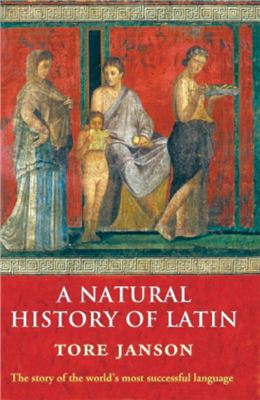Janson T. A Natural History of Latin. - Oxford University Press,
2004. - 316 p.
Latin is alive and well. Beginning in Rome around 600 BC Latin became the language of the civilized world and remained so for over two millennia. French, Spanish, Italian, and Romanian are among its progeny and it still provides the inteational vocabulary of law and life science. No known language, including English - itself enriched by Latin words and phrases - has achieved such success and longevity. Tore Janson tells its history from origins to the present. Brilliantly conceived and written with the same light touch as Speak, his bestselling history of languages, A Natural History of Latin is a masterpiece of adroit synthesis. The author charts the expansion in the classical world, its renewed importance in the Middle Ages, and its survival into mode times. He shows its central role in European history and culture and, by judicious quotation of phrases and texts, describes how spoken and written Latin changed and evolved differently in different places. He ends with a summary of Latin grammar and lists of Latin words and of phrases still in common use. Considered elitist and irrelevant in the second half of the twentieth century and often banned from schools, Latin is now enjoying a huge revival of interest and a renaissance in schools across Europe, the UK, and the USA. Tore Janson offers persuasive arguments for its value and direct access to its fascinating worlds, past and present.
Latin is alive and well. Beginning in Rome around 600 BC Latin became the language of the civilized world and remained so for over two millennia. French, Spanish, Italian, and Romanian are among its progeny and it still provides the inteational vocabulary of law and life science. No known language, including English - itself enriched by Latin words and phrases - has achieved such success and longevity. Tore Janson tells its history from origins to the present. Brilliantly conceived and written with the same light touch as Speak, his bestselling history of languages, A Natural History of Latin is a masterpiece of adroit synthesis. The author charts the expansion in the classical world, its renewed importance in the Middle Ages, and its survival into mode times. He shows its central role in European history and culture and, by judicious quotation of phrases and texts, describes how spoken and written Latin changed and evolved differently in different places. He ends with a summary of Latin grammar and lists of Latin words and of phrases still in common use. Considered elitist and irrelevant in the second half of the twentieth century and often banned from schools, Latin is now enjoying a huge revival of interest and a renaissance in schools across Europe, the UK, and the USA. Tore Janson offers persuasive arguments for its value and direct access to its fascinating worlds, past and present.

